Students must start practicing the questions from CBSE Sample Papers for Class 9 Science with Solutions Set 3 are designed as per the revised syllabus.
CBSE Sample Papers for Class 9 Science Set 3 with Solutions
Time Allowed : 3 Hours
Maximum Marks:80
General Instructions:
Read the following instructions carefully.
- This question paper consists of 39 questions in 5 sections,
-
All questions are compulsory. However, an internal choice is provided in some questions. A student is expected to
attempt only one of these questions. - Section A consists of 20 objective-type questions carrying 1 mark each.
-
Section B consists of 6 Very Short questions carrying 2 marks each. Answers to these questions should be in the range
of 30 to 50 words. -
Section C consists of 7 Short Answer type questions carrying 3 marks each. Answers to these questions should be in
the range of 50 to 80 words. -
Section D consists of 3 Long Answer type questions carrying 5 marks each. Answers to these questions should be in
the range of 80 to 120 words. - Section E consists of 3 source-based/case-based units of assessment of 4 marks each with sub-parts.
Section – A
(Select and write the most appropriate option out of the four options given for each of the questions 1 – 20. There is no negative mark for incorrect response:)
Question 1.
Identify the Mg ion from the figure where n and p represent the number of neutrons and protons respectively. [1]

Answer:
Option (D) is correct
Explanation: E’ectronic configuration of Mg atom = 2,8,2 and that of Mg
2+
ion = 2, 8
Number of protons in Mg atom = 12
Number of neutrons in Mg atom 24 – 12 = 12 [as mass number of Mg atom = 24 and number of neutrons = mass number – number of protons].
Question 2.
Which one of the following sets of phenomena would increase on raising the temperature? [1]
(A) Diffusion, evaporation, compression of gases
(B) Evaporation, compression of gases, solubility
(C) Evaporation, diffusion, expansion of gases
(D) Evaporation, solubility, diffusion, compression of gases.
Answer:
Option (D) is correct
Explanation: Evaporation rate increases because on increasing temperature. kinetic energy of molecules increases, so the molecules present at the surface of the liquid leave the surface quickly and go into the vapour state.
. . . . . . . . . . . . . . . . . . . . . . . . . . . . . . . . . . . . . . . . . . . . . . . . . . . . . . . .
Question 3.
A mixture of sulphur and carbon disulfide is: [1]
(A) Heterogeneous and shows Tyndall effect
(B) Homogeneous and shows Tyndall effect
(C) Heterogeneous and does not show Tyndall effect
(D) Homogeneous and does not show Tyndall effect.
Answer:
Option (A) is correct
Explanation: A mixture of sulphur and carbon disuiphide is a heterogeneous colloid and shows Tyndall effect. In a colloidal solution, the particles are big enough to scatter light. This phenomenon of scattering of light by colloidal particles is known as Tyndall effect.
Question 4.
Which of the following figures does not represent Bohr’s model of an atom correctly? [1]

(A) (i) and (ii)
(B) (ii) and (iii)
(C) (ii) and (iv)
(D) (i) and (iv)
Answer:
Option (C) is correct.
Explanation: Figures (ii) and (iv) do not correctly represent the Bohr’s model of an atom. It is because maximum number of electrons in K (I) shell is 2, not 4, so (ii) is wrong and maximum capacity of L. (II) shell is 8 electrons, not 9. So, (iv) is also wrong.
Question 5.
The chemical symbol for sodium is: [1]
(A) So
(B) Sd
(C) NA
(D) Na
Answer:
Option (D) is correct.
Explanation. The chemical symbol for sodium is ‘Na’ derived from Latin word natrium.
Question 6.
The property to flow is unique to fluids. Which one of the following statements is correct? [1]
(A) Only gases behave like fluids.
(B) Gases and solids behave like fluids.
(C) Gases and liquids behave like fluids.
(D) Only liquids are fluids.
Answer:
Option (C) is correct.
Explanation: Gases and liquids tend to flow due to less Force of attraction between their particles. Solids do not flow.
Question 7.
Which of these is an alloy? [1]
(A) Silver
(B) Copper
(C) Bronze
(D) Aluminium
Answer:
Option (C) is correct.
Explanation: Bronze is an alloy made from copper and tin.
Question 8.
Chromosomes are made up of: [1]
(A) DNA
(B) Protein
(C) DNA and protein
(D) RNA
Answer:
Option (C) is correct.
Explanation: Chromosomes are thread-like structures usually present in the nucleus which become visible only during cell division. Each chromosome is made up of DNA and proteins.
Question 9.
Which of the following tissues has dead cells? [1]
(A) Parenchyma
(B) Sclerenchyma
(C) Collenchvma
(D) Epithelial tissue
Answer:
Option (B) is correct.
Explanation: Sderenchyma provides hardness and stiffness to the plant and is composed of dead cells.
Question 10.
If the tip of the sugarcane plant is removed from the field, even then it keeps on growing in length. It is due to the presence of: [1]
(A) Carnhium
(B) Apical meristem
(C) Lateral meristem
(D) Intercalary meristem
Answer:
Option (D) is correct.
Explanation: Intercalary meristem divides and form new cells and add to the length of internodes. Thus, sugarcane can grow even when its tip is removed.
Question 11.
A person met with an accident in which two long bones of hand were dislocated Which among the following may he the possible reason? [1]
(A) Tendon break
(B) Break of skeletal muscle
(C) Ligament break
(D) Areolar tissue break
Answer:
Option (C) is correct.
Explanation: Dislocation of joint occurs when there is an abnormal separation in joint, which are held together by a ligament. Therefore ligament breaks and results in dislocation of bone.
Question 12.
Which of these options are not the functions of ribosomes?
(i) It helps in manufacture of protein molecules.
(ii) It helps in manufacture of enzymes.
(iii) It helps in manufacture of hormones.
(iv) It helps in manufacture of starch molecules.
(A) (1) and (ii)
(B) (ii) and (iii)
(C) (iii) and (iv)
(D) (iv) and (1)
Answer:
Option (C) is correct.
Explanation: Rihosomes are involved in protein synthesis. Almost all enzymes are proteins. Hence, ribosomes make enzymes too. Chemical structure of hormones is diverse including steroids, amino acids derivatives, proteins, and peptides. Hence, except proteinaceous hormones, all other types of hormones cannot be synthesized by ribosomes. Ribosomes are not involved in starch manufacture.
Question 13.
The slope of a velocity-time graph gives: [1]
(A) Distance
(B) Displacement
(C) Acceleration
(D) Speed.
Answer:
Option (C) is correct.
Explanation: Slope of velocity-time graph gives acceleration. It is because,
slope of the curve = \(\frac{u}{t}\) where \(\frac{u}{t}\) = acceleration
Question 14.
The gravitational force between two objects is F. If masses of both objects are halved without changing distance between them, then the gravitational force would become: [1]
(A) F/4
(B) F2
(C) F
(D) 2F
Answer:
Option (A) is correct.
Explanation: We know that, gravitational force,
F = \(\frac{\mathrm{Gm}_1 \mathrm{~m}_2}{r^2}\)
(G = Gravitational constant)
where m
1
and m
2
are the masses of two objects respectively. And r is the distance between the
two masses Now, according to the question, if masses of both objects are halved. i.e., m
1
= \( \frac{m_1}{2}\) and m
2
= \(\frac{m_2}{2}\)
New force,
F = \(\frac{G m_1^{\prime} m_2^{\prime}}{r^2}=\frac{G\left(\frac{m_1}{2}\right)\left(\frac{m_2}{2}\right)}{r^2}\)
= \(\frac{1}{4} \frac{\mathrm{Gm}_1 \mathrm{~m}_2}{r^2}\)
= \(\frac{F}{4}\) where \(\frac{\mathrm{Gm}_1 \mathrm{~m}_2}{r^2}\) = F
So, new Force F = \(\frac{F}{4}\)
Thus, the new gravitational force will become \(\frac{1}{4}\) times of its original gravitational force. I
Question 15.
Weeds affect the crop plants by: [1]
(A) Killing of plants in the field before they grow
(B) Dominating the plants to grow.
(C) Competing for various resources of crops (plants) causing low availability of nutrients.
(D) All of the above.
Answer:
Option (D) is correct.
Explanation: Weeds are unwanted plants in the cultivated fields. They compete with main crop plants for nutrients and reduce the growth of crops in many ways.
Question 16.
Which one is an oil-yielding plant among the following? [1]
(A) Lentil
(B) Sunflower
(C) Cauliflower
(D) Lotus
Answer:
Option (B) is correct.
Explanation: Sunflower is an oil-yielding plant.
Assertion-Reason Based Questions
Question No. 17 to 20 consist of two statements — Assertion (A) and Reason (R). Answer these questions selecting the appropriate option given below:
(A) Both (A) and (R) are true, and (R) is the correct explanation of (A).
(B) Both (A) and (R) are true, and (R) is not the correct explanation of (A).
(C) (A) is true but (R) is false.
(D) (A) is false but (R) is true.
Question 17.
Assertion (A): A gas exerts pressure on the walls of the container.
Reason (R): Rate of diffusion of gases is more than that of liquids. [1]
Answer:
Option (B) is correct.
Explanation: In the gaseous state, the particles move randomly at certain speed. Due to this movement, they hit each other and also on the walls of the container. This force exerts pressure on the walls.
Question 18.
Assertion (A): Permanent tissue is composed of mature cells.
Reason (R): Meristematic tissue is a group of actively dividing cells. [1]
Answer:
Option (B) is correct.
Explanation: Meristematic tissues are made up of actively dividing cells, present in the growing areas of the plant body where as Permanent tissue is a well-differentiated plant tissue derived from meristematic tissue, which has lost its ability to divide.
Question 19.
Assertion (A): The effect of thrust on sand is larger while standing than while lying.
Reason (R): Thrust is a force acting on an object perpendicular to the surface. [1]
Answer:
Option (B) is correct.
Explanation: When you stand on loose sand, the force is acting on the area equal to your feet. When you lie down, same force acts on the area equal to the whole body. Effect of the thrust depends upon the area on which it acts.
Question 20.
Assertion (A): Nitrogen is a micronutrient.
Reason (R): Micronutrients are nutrients required in small quantity. [1]
Answer:
Option (D) is correct.
Explanation: Nitrogen is a macronutrient. Macronutrients are nutrients required in large quantity while micronutrients are nutrients required in small quantity.
Section – B
(Questions No. 21 to 26 are very short answer questions)
Question 21.
List any two characteristics of colloid. [2]
Answer:
It is a heterogeneous mixture.
Particles of colloids scatter a beam of light (Tyndall effect).
Question 22.
What is endoplasmic reticulum? Name the two types of endoplasmic reticulum, Write its main functions.
Cell size may range from a few micro metre to a metre. Support this statement with the help of examples.
OR
Name the tissue which helps in transportation of oxygen that we inhale to various parts of our body. Write the composition of this tissue.[2]
Answer:
Endoplasmic reticulum is a membranous network enclosing a fluid-filled lumen. The two types of endoplasmic reticulum are Rough Endoplasmic Reticulum (RER) and Smooth Endoplasmic Reticulum (SER). RER has ribosomes attached to its surface. The ribosonies take part in protein synthesis.
False
Question 23.
Cell size may range from a few micro metre to a metre. Support this statement with the help of examples. [2]
OR
Name the tissue which helps in transportation of oxygen that we inhale to various parts of our body. Write the composition of this tissue.
Answer:
Cell size may range from few micrometers to a metre. This can be explained with the help of many examples like size of a bacterial cell is about 2-10 micrometers while cell of amoeba ranges from 10-100 micrometers An ostrich egg is about 15 cm in length and a nerve cell of giraffe is about 2m long.
OR
The tissue which helps in transportation of oxygen that we inhale to various parts of our body is blood.
It is composed of:
- RBC (red blood corpuscles),
- ‘NBC (white blood corpuscles) and
- Platelets.
Question 24.
Peter pours the same amount of four different liquids in separate cylinders.
The cylinders are of the same size.
He then drops a glass marble in each of the four cylinders.
He also notes the time the marble takes to reach the bottom of each cylinder.
The table shows the results.
| Liquid | Time taken by the marble to reach the bottom of the cylinder (in seconds) |
| Liquid 1 | 1.8 s |
| Liquid 2 | 1.5 s |
| Liquid 3 | 0.8s |
| Liquid 4 | 1.0s |
Which liquid exerted the most upward force on the marble? Justif your answer. [2]
Answer:
Liquid 1 exerted the most upward force on the marble. Due to this, the time taken by the marble dropped in liquid I to reach the bottom was more, as it had to overcome more force than other ones.
Question 25.
The picture shows four sound waves.
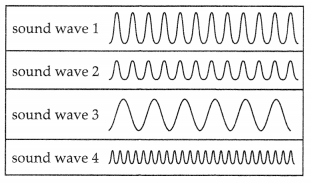
Which two sound waves have almost the same loudness? [2]
OR
Name the positions on Earth where the value of ‘g’ is
(i) maximum
(ii) minimum?
Justify your answer.
Answer:
Sound wave I and sound wave 3 will have almost the same loudness as they have almost same amplitude.
OR
On Earth, value of g is maximum at poles and minimum at the equator. We know;
g=GM/R
2
At poles radius of Earth is less so value of g is more, at equator radius of Earth is more so value of g is less.
Question 26.
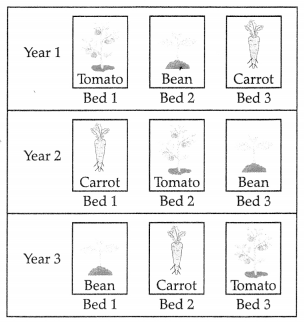
The diagram shows the crop harvesting pattern followed by a farmer. Bed 1, Bed 2, and Bed 3 are different parts of the farm.
(a) What is the common term used for this pattern of crop harvesting?
(b) What is the advantage of the crop harvesting pattern shown in the diagram? 2
Answer:
(a) Common term used for the pattern of crop harvesting shown in the diagram: Crop rotation
(b) Advantage of this method: Different nutrients present in the farm soil are evenly used over time.
Section – C
(Question No. 27 to 33 are short answer questions)
Question 27.
After winters, people pack off their woollens by keeping naphthalene balls in them. With passage of time these balls become smaller in size.
(a) Why does this happen?
(b) What type of change is involved during this process?
(c) How can you convert a saturated solution into an unsaturated solution? [3]
Answer:
(a) With time, naphthalene balls sublime directly into vapour.
(b) It is a physical change and the process is known as sublimation.
(c) We can convert a saturated solution into an unsaturated solution by adding large quantities of the solvent into the solution.
Question 28.
What do you mean by a concentration of a solution? Mention two ways, of expressing the concentration of a solution.
OR
Show the formation of chemical formulae of following compounds using their ions:
(a) Ammonium sulphate
(b) Magnesium nitrate
(c) Aluminium sulphide. [3]
Answer:
The concentration of a solution is the amount of solute present in a given amount (mass or volume) of solution, or the amount of solute dissolved in a given mass or volume of solvent. Two ways of expressing the concentration of a solution:
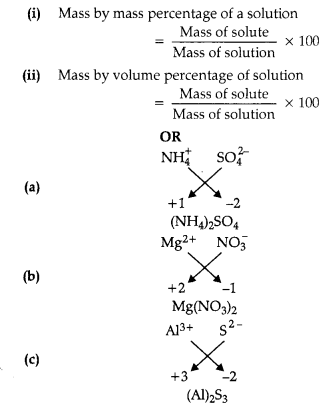
Question 29.
What is the energy currency of the cell? Write it in expanded form. Which cell organelle is related to the currency? [3]
Answer:
ATP is the energy currency of the cell. Its expanded form is Adenosine Triphosphate. Mitochondria is organelle related to the currency.
Question 30.
What are the small pores observed in the epidermis of the leaf called? Write its two main functions. [3]
Answer:
The small pores in the epidermis of the leaf are Stomata.
Two main functions of stomata are:
- They help in gaseous exchange.
- They help in loss of water in the form of water vapours from the leaves thereby causing cooling of leaves (transpiration).
Question 31.
A body of mass 1000 kg moving at a speed of 10 rn/s reaches the speed of 50 mi’s in 20s. Calculate the force required to do so.[3]
Answer:
Initial velocity (u) = 100 m/s
Final velocity (ν) = 50 m/s
Time (t) = 20s
Mass (m) = 1000 kg
Force = ms = m(v – u)/t
Or
F = 1000 \(\frac{(50-10)}{20}\)
= 2000 kgm/s
2
= 2000 N
Question 32.
What happens to the magnitude of the force of gravitation between two objects if:
(a) mass of one of the objects is tripled?
(b) distance between the objects is doubled?
(c) mass of both objects is doubled? [3]
Answer:
The force between two objects is given by ‘Universal gravitation law.’ It is numerically stated as,
F = \(\frac{\mathrm{G}\left(\mathrm{m}_1 \mathrm{~m}_2\right)}{d^2}\)
(a) Mass of one object is tripled:
F’ = \(\frac{\mathrm{G}\left(3 \mathrm{~m}_1\right) \mathrm{m}_2}{d^2}\)
F’= \(\frac{3 G\left(m_1 m_2\right)}{d^2} \) = 3F
Force will be tripled.
(b) Distance between the objects is double:
F’ = \(\frac{\mathrm{G}\left(\mathrm{m}_1 \mathrm{~m}_2\right)}{(2 d)^2}\)
F = \(\frac{G\left(m_1 m_2\right)}{4 d^2}\)
F = \(\frac{1}{4}\left(\frac{\mathrm{Gm}_1 \mathrm{~m}_2}{d^2}\right)=\frac{\mathrm{F}}{4}\)
Force will reduce to one-fourth of its previous value.
(c) Masses of both objects are doubled:
F’ = \(\frac{G\left\{\left(2 m_1\right)\left(2 m_2\right)\right\}}{d^2}\)
F’ = \(\frac{4 G\left\{m_1 m_2\right\}}{d^2}\) = 4F
Force will be four times greater than its previous value.
Question 33.
(a) Name the principle used to check purity of milk with lactometer.
(b) State the same principle.
(c) Write its another application. [3]
Answer:
(a) A lactometer is based on Archimedes’ principle.
(b) It states that when a body is immersed fully or partially in a fluid, it experiences an upward force that is equal to the weight of the fluid displaced by It.
(c) It is used in designing ships and submarines. It is also used in hydrometers used for determining density of liquids.
Section – D
(Question No. 34 to 36 are long answer questions)
Question 34.
(a) Out of boiling and evaporation which is a surface phenomenon? Explain. In the absence of a refrigerator, butter is kept wrapped in a wet cloth during summer. Why?
(b) Why does ice cream appear colder than water at the same temperature? [5]
OR
Classify different types of pure substances. Differentiate them on the basis of their chemical properties giving examples of each.
Answer:
(a) Evaporation is a surface phenomenon. Particles from the surface gain enough energy to overcome the forces of attraction present in the liquid and change into vapour state. Due to wet cloth, the temperature is comparatively lower than room temperature. So, butter does not melt when remain wrapped in wet clothes.
b) It is because the fact that water has latent heat of fusion present in it. But ice cream is in solid form; i.e. it has released its latent heat fusion of while coming in solid state. So due to less energy of ice cream in comparison to that of water; ice cream appears cooler to mouth than that of water at the same temperature.
OR
Two types of pure substances are elements and compounds.
Differences between elements and compounds are:
| Compound | Element |
| (1) A compound contains atoms of different elements chemically combined together in a fixed ratio. | An clement is a pure chemical substance made of same type of atom. |
| (2) Compounds contain different elements in a fixed ratio arranged in a defined manner through chemical bonds. | Elements are distinguished by their atomic number (number of protons in their nucleus). |
| (3) A compound can be separated into simpler Substances chemical methods/ reactions. | Elements cannot be broken down into simpler substances by chemical reactions. |
| (4) The list of compounds is endless. | There are about 117 elements that have been observed and can be classified as metal, non-metal or metalloid. |
| (5) A compound is represented using a formula. | An element is represented using symbols. |
| (6) e.g… Water (H 2 O), sodium chloride (NaCl), Sodium bicarbonate (NaHCO 3 ), etc. | e.g., iron, copper, silver, gold, and nickel, etc. |
Question 35.
Identify the following tissues:
(a) The epithelial tissue which has pillar-like tall cells?
(b) The cells of this tissue are filled with fat globules.
(c) The movement of this tissue pushes the mucus forward to clear respiratory tract.
(d) It gives buoyancy to lotus to help it stay afloat.
(e) Tissue present in lung alveoli. [5]
OR
(a) Explain the terms:
(i) Endocytosis,
(ii) Plasmolysis.
(b) What will happen if the organisation of a cell is damaged due to certain physical or chemical reasons?
(c) How do substances like CO
2
, and water move in and out of the cell? [5]
Answer:
(a) Columnar
(b) Adipose
(c) Ciliated columnar
(d) Aerenehyma
(e) Squamous.
OR
(a) (i) Endocytosis: The flexibility of the cell membrane enables the cell to engulf food and other materials from its external environment. Such a process is known as endocytosis.
True
lysosomes are also known as the “suicidal bags of the cell" when the organisation of a cell gets damaged, lysosomes will burst . lysosomes are also known as the “suicidal bags of the cell"
(c) Gases like CO 2 and O 2 , move in and out of the cell by diffusion from their higher concentration to lower concentration. Water enters the cell by endosmosis through semi-permeable plasma membrane from its higher concentration to its lower concentration. Similarly, water moves out of the cell by exosmosis when a cell is placed in a hypertonic solution.
Question 36.
(a) Give four differences between distance and displacement. The position-time graph for children ‘A and B’ returning from their school ‘O’ to their homes ‘P’ and ‘Q’ is shown in fig. From the graph find:
(i) Which of the two ‘A’ or ‘B’ lives closer to school?
(ii) Which of the two ‘A’ or ‘B’ starts earlier from school?
(iii) Which of the two ‘A’ or ‘B’ walks faster?
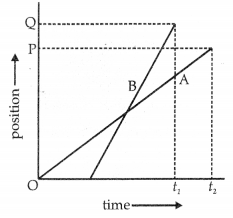
(b) The speed of a car increases from 18 km/h to 36 km in 10 seconds. Find its acceleration. 5
OR
(a) A bar of metal has a mass of 200 g and a certain weight. Mass remains the same when weighed at equator but weight decreases. Why?
(b) Differentiate between mass and weight. Write any four differences.
Answer:
(a)
| Distance | Displacement |
| (i) Distance is the length of the actual path covered by an object irrespective of its direction of motion. | Displacement is the shortest distance between the initial and final positions of an object in a given direction. |
| (ii) Distance is a scalar quantity. | Displacement is a vector quantity. |
| (iii) Distance covered can never be negative. It is always positive or zero. | Displacement may be positive. negative or zero. |
| (iv) Distance between two given points may be same or different for different paths chosen. | Displacement between two given points is always the same. |
(i) A
(ii) A
(iii) B
(b) Given,
u = 18 km/h = 5 m/s
ν = 36 km/h = 10 m/s,
t = 10s
a = \(\frac{(10-5)}{10}\\) = 0.5 m/s
2
OR
(a) Weight is dependent on gravitational force. Since, on equator, the gravitational force is less, so the weight of the bar of metal decreases.
(b) Difference between mass and weight :
| Mass | Weight |
| (i) Its value remains constant at all places. | Its Value changes from place to place due to change in the’g’. |
| (ii) It is a scalar quantity. | It is a vector quantity. |
| (iii) It is never zero. | It is zero for away from the Earth. |
| (iv) Its unit is kg. | Its unit is N or kg-wt. |
Section – E
(Questions No. 37 to 39 are case-based! data-based questions with 2 to 3 short sub-parts. Internal choice is provided in one of these sub-parts.)
Question 37.
The following data represents the distribution of electrons, protons, and neutrons in atoms of three elements A, B, and C Understand the data carefully and answer the following questions.
| Element | Protons | Neutrons | Electrons |
| A | 9 | 10 | 9 |
| B | 16 | 16 | 16 |
| C | 12 | 12 | 12 |
(a) What is the atomic number of element A?
(b) What will he the atomic mass number of element B?
(c) Atomic number of element C is 12. Identify the element and write its electronic configuration. [4]
OR
What will be the valency of element A? Justify your answer.
Answer:
(a) 9
(b) 32
(c) Element magnesium has atomic number 12. So, element C is magnesium. Its electronic configuration will be 2,8, 2.
OR
Valency of element A will be 1. This is because it will have electronic configuration: (2, 7).
It will accept one electron. So its valency will be 1.
Question 38.
Study the given diagram of bacterial cells and answer the following questions.
(a) The bacterial cell shown in the diagram does not have a well-defined nucleus. What type of cell it is?
(b) Identify and name the part numbered as (1) in the diagram.
(c) Identify the parts numbered as (3) in the diagram. What is its function? [4]
Or
Identify the part shown by number (2). What does it contain?
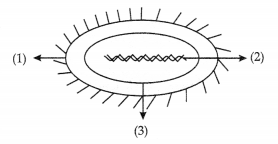
Answer:
(a) Prokaryotic cell
(b) Cell wall
(c) Plasma membrane function: Protection and transport.
OR
Nucleoid. it contains chromosomes.
Question 39.
Observe the diagram and answer the following below:
Two forces F
1
=20 N and F
2
= 30 N are acting on an object as shown in figure:
(a) Find the net force acting on the object.
(b) State the direction of the net force acting on the object.
(c) If the object still does not move under the application of these forces, what can be the possible reason for this? [4]
OR
Why no force is required to move an object with a constant velocity?
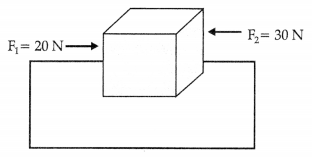
Answer:
(a) Net force acting on the object = F
2
– F
1
= 30 N-20N = 10N
(b) Net force acts in the direction of force F
2
. As F
2
is greater than F
1
.
(c) All forces acting on the object are balanced and that is why the object does not move. It needs unbalanced force for movement.
OR
We know, F = ma
When velocity is constant, then acceleration, a = 0. Hence, F = 0. Hence, no force is required to move an object with constant velocity.